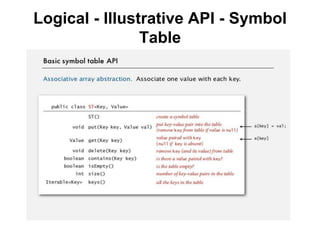Data structures logical and physical
- 1. Logical and Physical Data Structures - A way of understanding data structures - References: 1. Algorithms - Princeton - Coursera 2. Algorithms Booksite
- 2. Logical Data structures - definition A logical data structure is defined by its API and the semantics of each of the APIs. It does not either imply the physical implementation of the data structure nor necessitate a specific implementation. While several implementations exist for each logical data structure some are optimal vis-a-vis others.
- 3. Logical Some of the logical data structures include ˇń Stacks ˇń Queues o Priority Queues ˇń Bags ˇń Symbol Tables
- 4. Logical - Illustrative API - Symbol Table
- 5. Physical - Generic Physical data structures are constructed based on the organization of the computing machine. The memory structures both scale and hierarchy, instruction set both operations and registers drive the physical design of a data structure. There are two physical implementations of data structures at the most generic abstraction level for a computing machine (a deterministic turing machine as opposed to a quantum). ˇń Arrays ˇń Graphs
- 6. Physical - Specialized The two generic physical data structures can be further specialized as follows ˇń Array o unordered array o ordered array ˇń Graph o Linked Lists o Trees ? Binary Trees ˇń Binary Search Trees o Self Balancing Binary Search Trees ? Left Leaning Red Black Tree ? ˇ. o Acyclic Graphs ? Directed Acyclic Graphs ? ˇ. o Cyclic Graphs ? ... o And all other variants ? 2-3 Trees ? B-Trees ? Tries
- 7. Physical - Illustrative Implementations - Symbol Table







